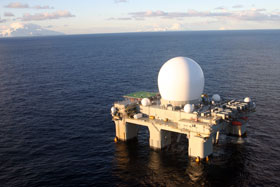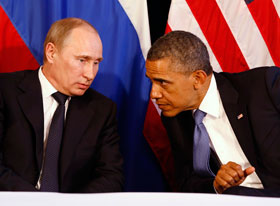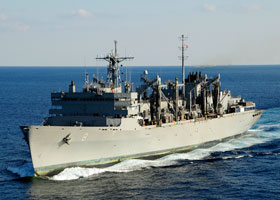With increased competition for resources in the Arctic, it is urgent for Russia to build a policy of cooperation with such influential countries as the United States. Is there any potential for such cooperation? Or is the US focused on a unilateral course of action in this region?
What the Arctic means for the USA
The Arctic coast of the United States is in Alaska, whose continental shelf, according to the National Geological Survey, has about 31% of undiscovered oil reserves of the entire Arctic, which amounts to 27 billion barrels. Gas is also expected to be found there but in much smaller quantities.
The Arctic remains a strategically important region for the U.S. nuclear submarine fleet. From the north-east of the Barents Sea, the US can strike most important targets because here lies the shortest path for ballistic missiles aimed from the eastern to the western hemisphere.
NORAD infrastructure covering the USA and Canada with northern strategic direction is located in Alaska.
Many experts are noting a change in Washington’s motivation in the Far North. Military and strategic confrontation with the Soviet Union was the main activity during the Cold War, whereas now, economic interests – access to oil and gas resources in the Arctic – are the primary goal. Such companies as Chevron, ExxonMobil, and ConocoPhillips are the most active in the Arctic.
A review of the U.S. policy and interests in the Arctic began after 2004 due to the revival of Russia’s activities in the Far North.
Components of the U.S. Arctic strategy
The U.S. Arctic Policy Directive was published on January 12, 2009.
It states that “the United States has broad and fundamental national security interests in the Arctic region and was prepared to operate either independently or in conjunction with other states to safeguard these interests”. In the Arctic, maximum implementation of the principle of freedom of navigation and economic activity is beneficial for Washington because the US is not a signatory to the UN Convention on the Law of the Sea, which makes it possible to make a claim in disputed cases on a section of the shelf. The American interests, formally stated, can be grouped into several categories:
- Military and strategic interests – missile defense and early warning; deployment of sea and air systems for strategic redeployment of forces in the Arctic; strategic deterrence, maritime security operations; and ensuring freedom of navigation and over-flight. The US is prepared to act unilaterally if necessary to protect these interests.
- Homeland security interests – prevention of terrorist attacks or other criminal or hostile acts that could increase the United States vulnerability to terrorism in the Arctic region.
- Political and economic interests – expansion of American economic presence under simultaneous demonstration of naval power. The US is ready not only to defend its rights in the exclusive economic zone (200 nautical miles from the shore), but also to ensure “adequate” control of adjoining water areas. Freedom of transarctic over-flights and freedom of navigation for the entire Arctic, including the Northern Sea Route which runs along Russia’s territory, were named as top national priority.
In this way, the U.S. Arctic strategy reserves the right to act not just unilaterally, but also to control Arctic spaces outside legally valid boundaries.
In furtherance of the provisions of this Directive, the U.S. Navy Arctic Roadmap was published in October 2009, it contained a five-year plan of expanding maritime operations in the Arctic. Equipping the armed forces with weapons, detection, communication and control systems, as well as other objects of military and civilian infrastructure, adapted to the conditions of the Arctic, was named as one of the goals of this Roadmap. The Roadmap includes improvement of sea-based systems to protect against ballistic and cruise missiles, forces and means to fight submarines and control the coastal zone.
The Roadmap provides for the creation of a strategic unit to study the effects of climate change for strategic objectives and the nature of maritime operations in the Arctic. Constant monitoring of security threats to U.S. interests, exploring the capabilities of closest rivals in the Arctic, analysis of actions and motivations of all governmental and non-governmental members of the Arctic Policy are all under the focus of attention of this Roadmap. Military research is an important part of the Roadmap.
The provisions of the Arctic strategy are consecutively being implemented in practical politics. This is indicated by the plans on increasing the U.S. military satellite systems, aimed at the Arctic.
Under Barack Obama, the US has stepped up the activities of air defense systems designed to intercept Russian strategic air forces patrolling the Arctic and North Atlantic. There is plan to increase the presence of the U.S. nuclear submarine fleet in the Barents Sea, which is working out operational activities in the Arctic. Exercises involving the Naval and Air Forces are held in the Chukchi Sea near Russian territorial waters. Discussions are continuing in the USA on the construction of nuclear icebreakers to support maritime operations in the Arctic. An accompanying report to a bill adopted by the Congress says that one of the missions of the Coast Guard is to “provide the United States with the capability to support national interests in the Polar Regions...The United States will need a maritime surface and air presence in the Arctic sufficient to support appropriate prevention and response regimes as well as diplomatic objectives”.
In recent years, the United States has actively participated in NATO exercises in the Arctic region. It is obvious that the United States, along with other Western countries, plans to increase multilateral military cooperation in the Arctic.
To implement the Arctic strategy, the Obama administration made efforts for the U.S. Senate to fast-track ratification of the United Nations Convention on the Law of the Sea of 1982. This will not only include the United States in the legal mechanism of coordinating policies with other Arctic states, but will also give it the opportunity to expand extraction of mineral resources beyond the 200-mile radius. However, the principle of freedom of navigation for American ships is in conflict with restrictions that are imposed by this Convention. The U.S. Congress maintains strong opposition to the US accession to the Convention, as the consequences of such a move are fraught with financial losses for some American companies that are already developing various resources on the shelves of other countries. Many conservative republicans are against the accession.
Between rivalry and cooperation
Obvious and hidden differences between the United States and Russia on Arctic issues are in several directions. Like many other countries, the United States seeks to ensure that the status of the Northern Sea Route, running along the Arctic coast of Russia, becomes international. In the case these plans are implemented, Russia would not only lose significant revenues for the use of the route by other countries, but this will objectively increase Russia’s military and strategic vulnerability from the north.
Moscow and Washington see the leading regional organization – Arctic Council – in different ways. Russia is interested in expanding the powers of this Council, while the 2009 Directive explicitly states that the United States considers the Council only as a forum for discussion and is opposed to giving it the status of an international organization that makes binding decisions.
On the other hand, the United States strongly supports the strengthening of NATO’s presence in the Arctic, actually pushing out other international organizations (the Arctic Council and the Barents Euro-Arctic Council in which the US.A. is not a member). Given the current nature of relations between Russia and NATO, such steps would have negative consequences for Russia with no reliable allies in the Arctic.
Until the USA ratifies the UN Convention on the Law of the Sea, there remains the possibility of worsening of disputes with Russia on borders in the Arctic seas and on the continental shelf boundary. It should be remembered that the United States negatively views Russia’s attempts to expand its zone of the shelf to the Lomonosov and Mendeleev ridges. Russia’s application was rejected in 2001 due to the pressure on the UN Commission on the Limits of the Continental Shelf from the State Department. Russia has not ratified its treaty with the USA on the Bering Sea boundary line.
However, relations between the United States and Russia have significant potential for cooperation in the Arctic. According to experts, such relations are based on the Ilulissat Declaration signed by the “Arctic five” in May 2008, which states that the Convention on the Law of the Sea of 1982 was recognized as the legal basis for drawing borders, and that the parties intended to resolve problems through negotiations. In keeping with the general aspirations of Barack Obama to restart relations with Russia, there were statements including that of the U.S. President himself and Secretary of State on U.S. intentions to cooperate with Russia in the Arctic. However, it is likely that cooperation will only be in those areas where the USA. cannot do without Russian participation.
In particular, this concerns measures on ensuring the safety of water and air transportation in the Arctic, on which Member States of the Arctic Council signed an Agreement in May 2011. Each of the signatories undertook to build forces and resources to ensure safety in its segment and rapid exchange of information.
There is plan for a large-scale cooperation in the development of the resources of the Arctic zone of Russia. Rosneft and Exxon-Mobil – Russian and American companies, respectively – in April 2012 signed an agreement on cooperation in the exploration and development of oil and gas deposits in the Kara Sea.
Russia benefits from attracting the needed financial resources (Exxon-Mobil has capitalization of $400 billion) and modern technologies for exploration and drilling in the northern latitudes. Rosneft and ConocoPhillips, an American multinational energy corporation, are implementing another joint project at Nenets Autonomous District where they are developing the promising Ardalinskoye field. The American party is expected to increase investments.
Another direction of bilateral cooperation is the development of transantarctic routes for flights, involving development of communications infrastructure and maintenance, upgrade and construction of new airports in Russia. This airline market segment is the fastest growing.
Cooperation between the United States and Russia in the scientific study and nature conservation activities in the Arctic was and remains mutually beneficial. It is obvious that any decisions relating to the economic development of the Far North should be based on scientific analysis of the vulnerability of the northern nature and difficult weather, social, domestic and other conditions. In this respect, Russia can offer icebreaking fleet and its rich experience in Arctic expeditions.
In the military and political aspect of relations between Washington and Moscow, it is overdue for the two parties to strengthen measures on mutual military and political trust in the Arctic. Such measures should include mutual warning about plans for the movement of naval forces in “sensitive” zones, and limiting military presence in the Arctic.
At present, it is difficult to predict how relations between the United States and Russia in the Arctic will develop. This will depend, first, on the general mood in Russian-American relations, which may change if Republicans come to power in the USA. Secondly, it will depend on the effectiveness of Russia’s economic policy in the Arctic on attracting foreign investments and technology. Some positive steps have already been taken in this regard. Thirdly, it will depend on whether the US will maintain its present course of predominantly unilateral action in the region, or whether it will opt for multilateral cooperation.








